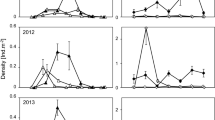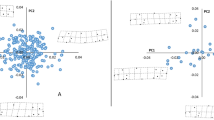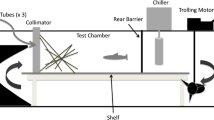Abstract
The availability of food, and hence energy, is known to influence the abundance, habitat choice and growth of individuals. In contrast, there is a paucity of knowledge on how the interaction of energy supply and social status determines patterns of residency and movement. This study tests whether the presence of conspecifics and an individual’s social status in relation to food supply influence the fitness and movement of a drift-feeding fish (Galaxias fasciatus). Using an information-theoretic approach (AIC), our analysis indicated that the most parsimonious model of fish movement among pools was one that included food supply, social rank and fish relative growth rate. Our results indicated that subordinate fish relocated more frequently compared to dominant fish, most likely as a consequence of intra-specific competition that limited the access of these smaller fish to resources and constrained their growth. Our results suggest that energy constraints may force individuals to explore new habitats in an effort to find more energetically profitable patches. We conclude that intra-specific competition mediated through the social hierarchy amongst closely interacting individuals plays a key role in determining individual growth, residency and relocation.



Similar content being viewed by others
References
Akaike H (1973) Information theory as an extension of the maximum likelihood principle. In: Petrov BN, Caski F (eds) Second international symposium on information theory. Akademiai Kiado, Budapest, pp 267–281
Akbaripasand A (2012) Habitat use, growth and movement in relation to bioenergetics of drift-feeding stream fish. PhD dissertation, University of Otago, Dunedin
Akbaripasand A, Nichol EC, Lokman PM, Closs GP (2011) Microhabitat use of a native New Zealand galaxiid fish, Galaxias fasciatus. NZ J Mar Freshw Res 45:135–144. doi:10.1080/00288330.2010.544044
Akbaripasand A, Krkosek M, Lokman PM, Closs GP (2014) Can drifting invertebrates meet the energy requirements of drift-feeding fish? A case study on Galaxias fasciatus. Freshw Sci. doi:10.1086/676957
Alanärä A, Burns MD, Metcalfe NB (2001) Intraspecific resource partitioning in brown trout: the temporal distribution of foraging is determined by social rank. J Anim Ecol 70:980–986. doi:10.1046/j.0021-8790.2001.00550.x
Bachman RA (1984) Foraging behavior of free-ranging wild and hatchery brown trout in a stream. Trans Am Fish Soc 113:1–32. doi:10.1577/1548-8659(1984)
Bartoń K (2013) MuMIn: Multi-model inference. R package version 1.9.5. Available at: http://CRAN.R-project.org/package=MuMIn
Bates D, Maechler M, Bolker B, Walker S (2013) lme4: Linear mixed-effects models using Eigen and S4 classes. R package version 1.0-5. Available at: http://CRAN.R-project.org/package=lme4
Bennetts RE, Kitchens WM (2000) Factors influencing movement probabilities of a nomadic food specialist: proximate foraging benefits or ultimate gains from exploration? Oikos 91:459–467. doi:10.1034/j.1600-0706.2000.910306.x
Biro PA, Post JR, Parkinson EA (2003) From individuals to populations: prey fish risk-taking mediates mortality in whole-system experiments. Ecology 84:2419–2431. doi:10.1890/02-0416
Boss SM, Richardson JS (2002) Effects of food and cover on the growth, survival, and movement of cutthroat trout (Oncorhynchus clarki) in coastal streams. Can J Fish Aquat Sci 59:1044–1053. doi:10.1139/f02-079
Burnham KP, Anderson DR (2002) Model selection and multimodel inference: a practical information-theoretic approach, 2nd edn. Springer, New York
Crampton LH, Longland WS, Murphy DD, Sedinger JS (2011) Food abundance determines distribution and density of a frugivorous bird across seasons. Oikos 120:65–76. doi:10.1111/j.1600-0706.2010.18624.x
David BO, Stoffels RJ (2003) Spatial organisation and behavioural interaction of giant kokopu (Galaxias argenteus) in two stream pools differing in fish density. N Z J Mar Freshw Res 37:315–322. doi:10.1080/00288330.2003.9517169
David BO, Closs GP, Crow SK, Hansen EA (2007) Is diel activity determined by social rank in a drift-feeding stream fish dominance hierarchy? Anim Behav 74:259–263. doi:10.1016/j.anbehav.2006.08.015
Dill LM, Fraser AHG (1984) Risk of predation and the feeding behavior of juvenile coho salmon (Oncorhynchus kisutch). Behav Ecol Sociobiol 16:65–71. doi:10.1007/BF00293105
Fausch KD (1984) Profitable stream positions for salmonids-relating specific growth-rate to net energy gain. Can J Zool 62:441–451. doi:10.1139/z84-067
Finstad AG, Armstrong JD, Nislow KH (2011) Freshwater habitat requirements of Atlantic salmon. In: Aas Ø, Einum S, Klemetsen A, Skurdal J (eds) Atlantic salmon ecology, 1st edn. Wiley, New York, pp 67–88
Gelman A, Su Y-S (2013) arm: data analysis using regression and multilevel/hierarchical models. R package version 1.6-10. Available at: http://CRAN.R-project.org/package=arm
Gowan C, Fausch KD (2002) Why do foraging stream salmonids move during summer? Environ Biol Fish 64:139–153. doi:10.1023/A:1016010723609
Grobler JMB, Wood CM (2013) The physiology of rainbow trout in social hierarchies: two ways of looking at the same data. J Comp Physiol B 183:787–799. doi:10.1007/s00360-013-0752-5
Grueber CE, Nakagawa S, Laws RJ, Jamieson IG (2011) Multimodel inference in ecology and evolution: challenges and solutions. J Evol Biol 24:699–711. doi:10.1111/j.1420-9101.2010.02210.x
Halstead MDB (1994) Detection and location of prey by the New Zealand freshwater galaxiid, Galaxias fasciatus (Pisces: Salmoniformes). Master thesis, The University of Auckland, Auckland
Hansen EA, Closs GP (2005) Diel activity and home range size in relation to food supply in a drift-feeding stream fish. Behav Ecol 16:640–648. doi:10.1093/beheco/ari036
Hansen EA, Closs GP (2009) Long-term growth and movement in relation to food supply and social status in a stream fish. Behav Ecol 20:616–623. doi:10.1093/beheco/arp039
Hasegawa K, Yamamoto S (2010) The effect of flow regime on the occurrence of interference and exploitative competition in a salmonid species, white-spotted char (Salvelinus leucomaenis). Can J Fish Aquat Sci 67:1776–1781. doi:10.1139/f10-100
Höjesjö J, Økland F, Sundström LF, Pettersson J, Johnsson JI (2007) Movement and home range in relation to dominance; a telemetry study on brown trout Salmo trutta. J Fish Biol 70:257–268. doi:10.1111/j.1095-8649.2006.01299.x
Hopkins CL (1979a) Age-related growth characteristics of Galaxias fasciatus (Salmoniformes: Galaxiidae). N Z J Mar Freshw Res 13:39–46. doi:10.1080/00288330.1979.9515779
Hopkins CL (1979b) Reproduction in Galaxias fasciatus Gray (Salmoniformes: Galaxiidae). N Z J Mar Freshw Res 13:225–230. doi:10.1080/00288330.1979.9515797
Hughes NF (1992) Ranking of feeding positions by drift-feeding Arctic grayling (Thymallus arcticus) in dominance hierarchies. Can J Fish Aquat Sci 49:1994–1998. doi:10.1139/f92-222
Hughes NF (1998) A model of habitat selection by drift-feeding stream salmonids at different scales. Ecology 79:281–294. doi:10.1890/0012-9658(1998)
Jonsson B, Jonsson N (2011) Ecology of Atlantic salmon and brown trout: habitat as a template for life histories. Springer, Dordrecht. doi:10.1007/978-94-007-1189-1
Kramer DL, Chapman MR (1999) Implications of fish home range size and relocation for marine reserve function. Environ Biol Fish 55:65–79. doi:10.1023/A:1007481206399
Lee G, Grant JWA, Comolli P (2011) Dominant convict cichlids (Amatitlania nigrofasciata) grow faster than subordinates when fed an equal ration. Behaviour 148:877–887. doi:10.1163/000579511X581747
MacLean A, Huntingford FA, Ruxton GD, Morgan IJ, Hamilton J, Armstrong JD (2005) Testing the assumptions of the ideal despotic distribution with an unpredictable food supply: experiments in juvenile salmon. J Anim Ecol 74:214–225. doi:10.1111/j.1365-2656.2005.00927.x
Martin AE, Hoover TM, Richardson JS (2013) Modeling the role of stage-structured agonistic interactions in ontogenetic habitat shifts. Behav Ecol 24:355–365. doi:10.1093/beheco/ars171
McDowall RM (1990) New Zealand freshwater fishes: a natural history and guide. Heinemann, Auckland
McNicol RE, Noakes DLG (1981) Territories and territorial defense in juvenile brook charr, Salvelinus fontinalis (Pisces: Salmonidae). Can J Zool 59:22–28. doi:10.1139/z81-005
Metcalfe NB (1986) Intraspecific variation in competitive ability and food intake in salmonids: consequences for energy budgets and growth rates. J Fish Biol 28:525–531. doi:10.1111/j.1095-8649.1986.tb05190.x
Metcalfe NB, Wright PJ, Thorpe JE (1992) Relationships between social status, otolith size at first feeding and subsequent growth in Atlantic salmon (Salmo salar). J Anim Ecol 61:585–589. doi:10.2307/5613
Metcalfe NB, Taylor AC, Thorpe JE (1995) Metabolic rate, social status and life-history strategies in Atlantic salmon. Anim Behav 49:431–436. doi:10.1006/anbe.1995.0056
Nakano S (1995) Individual differences in resource use, growth and emigration under the influence of a dominance hierarchy in fluvial red-spotted masu salmon in a natural habitat. J Anim Ecol 64:75–84. doi:10.2307/5828
Nakano S, Kachi T, Nagoshi M (1991) Individual growth variation of red-spotted masu salmon, Oncorhynchus masou rhodurus, in a mountain stream. Jpn J Ichthyol 38:263–270
Parker GA (1978) Searching for mates. In: Krebs JR, Davies NB (eds) Behavioural ecology: an evolutionary approach, 1st edn. Blackwell, Oxford, pp 214–244
Parker GA, Sutherland WJ (1986) Ideal free distributions when individuals differ in competitive ability: phenotype-limited ideal free models. Anim Behav 34:1222–1242. doi:10.1016/S0003-3472(86)80182-8
R Core Development Team (2013) R: A language and environment for statistical computing, version 3.0.1. R foundation for statistical computing, Vienna, Austria. Available at: http://www.R-project.org
Railsback SF, Lamberson RH, Harvey BC, Duffy WE (1999) Movement rules for individual-based models of stream fish. Ecol Model 123:73–89. doi:10.1016/S0304-3800(99)00124-6
Rhodes JS, Quinn TP (1998) Factors affecting the outcome of territorial contests between hatchery and naturally reared coho salmon parr in the laboratory. J Fish Biol 53:1220–1230. doi:10.1111/j.1095-8649.1998.tb00243.x
Rosenfeld JS, Boss S (2001) Fitness consequences of habitat use for juvenile cutthroat trout: energetic costs and benefits in pools and riffles. Can J Fish Aquat Sci 58:585–593. doi:10.1139/f01-019
Rowe DK, Smith J, Quinn J, Boothroyd I (2002) Effects of logging with and without riparian strips on fish species abundance, mean size, and the structure of native fish assemblages in Coromandel, New Zealand, streams. N Z J Mar Freshw Res 36:67–79. doi:10.1080/00288330.2002.9517071
Schielzeth H (2010) Simple means to improve the interpretability of regression coefficients. Methods Ecol Evol 1:103–113. doi:10.1111/j.2041-210X.2010.00012.x
Segers FHID, Taborsky B (2012) Competition level determines compensatory growth abilities. Behav Ecol 23:665–671. doi:10.1093/beheco/ars013
Soldánová M, Kuris AM, Scholz T, Lafferty KD (2012) The role of spatial and temporal heterogeneity and competition in structuring trematode communities in the great pond snail, Lymnaea stagnalis (L.). J Parasitol 98:460–471. doi:10.1645/GE-2964.1
Sundström LF, Petersson E, Höjesjö J, Johnsson JI, Järvi T (2004) Hatchery selection promotes boldness in newly hatched brown trout (Salmo trutta): implications for dominance. Behav Ecol 15:192–198. doi:10.1093/beheco/arg089
Van Leeuwen TE, Rosenfeld JS, Richards JG (2011) Failure of physiological metrics to predict dominance in juvenile Pacific salmon (Oncorhynchus spp.): habitat effects on the allometry of growth in dominance hierarchies. Can J Fish Aquat Sci 68:1811–1818. doi:10.1139/f2011-099
Wauters LA, Verbeylen G, Preatoni D, Martinoli A, Matthysen E (2010) Dispersal and habitat cuing of Eurasian red squirrels in fragmented habitats. Popul Ecol 52:527–536. doi:10.1007/s10144-010-0203-z
Webster MS, Hixon MA (2000) Mechanisms and individual consequences of intraspecific competition in a coral-reef fish. Mar Ecol Prog Ser 196:187–194. doi:10.3354/meps196187
Whitehead AL, David BO, Closs GP (2002) Ontogenetic shift in nocturnal microhabitat selection by giant kokopu in a New Zealand stream. J Fish Biol 61:1373–1385. doi:10.1006/jfbi.2002.2147
Whiteman EA, Côté IM (2004) Dominance hierarchies in group-living cleaning gobies: causes and foraging consequences. Anim Behav 67:239–247. doi:10.1016/j.anbehav.2003.04.006
Wilzbach MA (1985) Relative roles of food abundance and cover in determining the habitat distribution of stream-dwelling cutthroat trout (Salmo clarki). Can J Fish Aquat Sci 42:1668–1672. doi:10.1139/f85-208
Acknowledgments
Many thanks to Imelda Velasquez, Hadi Pourbagher, Francis Magbanua and Amir Hamidian for their assistance with field data collection. We thank Nicky McHugh and Kim Garrett for their support in the lab and field and also Alistair Senior, Katharina Lange and Manna Warburton for their analytical advice. We are grateful to Dr. L.A. Barmuta from the University of Tasmania and to two anonymous reviewers for their invaluable comments on the manuscript. Funding was provided by the Department of Zoology, University of Otago. All experiments comply with current New Zealand laws.
Author information
Authors and Affiliations
Corresponding author
Additional information
Communicated by Leon A. Barmuta.
Rights and permissions
About this article
Cite this article
Akbaripasand, A., Krkosek, M., Lokman, P.M. et al. Does social status within a dominance hierarchy mediate individual growth, residency and relocation?. Oecologia 176, 771–779 (2014). https://doi.org/10.1007/s00442-014-3038-z
Received:
Accepted:
Published:
Issue Date:
DOI: https://doi.org/10.1007/s00442-014-3038-z




